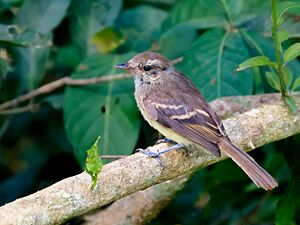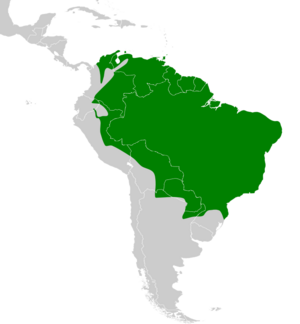Fuscous flycatcher facts for kids
Quick facts for kids Fuscous flycatcher |
|
|---|---|
 |
|
| Conservation status | |
| Scientific classification | |
 |
The fuscous flycatcher (Cnemotriccus fuscatus) is a small bird that belongs to the tyrant flycatcher family. It is the only bird in its group, called Cnemotriccus. These birds live in many parts of South America. You can find them from Colombia and Venezuela all the way south to Bolivia, Paraguay, and Argentina. They also live on the islands of Trinidad and Tobago.
This little flycatcher is found across northern and eastern South America. This includes the huge Amazon Basin and the Guianas. It also lives in almost all of Brazil.
Contents
What it Looks Like
The fuscous flycatcher is about 14.5 centimeters (about 5.7 inches) long. It weighs around 11.9 grams (about 0.4 ounces). It has a long tail. Its top feathers are plain brown. The wings are a darker brown and have two light, buff-colored stripes.
This bird has a clear, long, whitish stripe above its eye. This stripe is called a supercilium. Its beak is black. The chest is grey-brown, and its belly is a pale yellow. Male and female fuscous flycatchers look very similar. There are different types, or "races," of this bird. They might have slightly different shades of brown or yellow feathers.
Where it Lives and Makes its Home
Fuscous flycatchers like to live in woodlands and bushy areas. They often stay hidden in the undergrowth. This means they prefer to be in the lower plants and bushes.
Their nests are built carefully. They use small twigs and pieces of bark. The inside of the nest is soft, lined with plant fibers. They usually place their nest in a tree fork. This is where a tree branch splits into two.
Reproduction and Life Cycle
A typical nest will hold three white eggs. These eggs have black marks on the wider end. This helps to camouflage them.
How it Behaves
Fuscous flycatchers are not very easy to spot. They tend to stay hidden on perches in the undergrowth. From these spots, they quickly fly out to catch insects. This way of catching food is called "hawking." It means they dart out to grab insects in mid-air.
These birds have different calls. One common call is a soft chip. Their song can sound like chip-weeti-weeti-weetiyee. In the southern parts of their range, their morning song is more explosive. It sounds like pit-pit-peedit.


